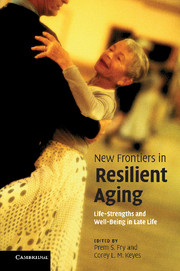Book contents
- Frontmatter
- Contents
- Figures
- Notes on contributors
- Foreword
- Acknowledgments
- Introduction
- 1 Sources of human life-strengths, resilience, and health
- 2 Growth is not just for the young: growth narratives, eudaimonic resilience, and the aging self
- 3 Physical resilience and aging:
- 4 You can teach an old dog new tricks:
- 5 Resilience in the face of cognitive aging:
- 6 Why do some people thrive while others succumb to disease and stagnation?
- 7 Psychosocial resources as predictors of resilience and healthy longevity of older widows
- 8 Resilience and longevity:
- 9 The socioemotional basis of resilience in later life
- 10 Emotional resilience and beyond:
- 11 Risk, resilience, and life-course fit:
- 12 Resilience in mobility in the context of chronic disease and aging:
- 13 Positive aging:
- Index
- References
10 - Emotional resilience and beyond:
a synthesis of findings from lifespan psychology and psychopathology
Published online by Cambridge University Press: 06 December 2010
- Frontmatter
- Contents
- Figures
- Notes on contributors
- Foreword
- Acknowledgments
- Introduction
- 1 Sources of human life-strengths, resilience, and health
- 2 Growth is not just for the young: growth narratives, eudaimonic resilience, and the aging self
- 3 Physical resilience and aging:
- 4 You can teach an old dog new tricks:
- 5 Resilience in the face of cognitive aging:
- 6 Why do some people thrive while others succumb to disease and stagnation?
- 7 Psychosocial resources as predictors of resilience and healthy longevity of older widows
- 8 Resilience and longevity:
- 9 The socioemotional basis of resilience in later life
- 10 Emotional resilience and beyond:
- 11 Risk, resilience, and life-course fit:
- 12 Resilience in mobility in the context of chronic disease and aging:
- 13 Positive aging:
- Index
- References
Summary
Abstract
The aim of the chapter is to attempt a synthesis of age-comparative research on emotional resilience. To do so, we integrate extant studies on age-related differences in indicators of normal and successful aging and indicators of psychopathology (emotional well-being/depressive disorders). Our review of empirical findings underscores the enormous emotional reserve capacity of aging individuals proposed by previous research. For example, in contrast to old-age stereotypes, negative affect as well as major depression do not occur more often in old age compared with younger ages; in young old age, negative emotional states even seem to be less frequent. However, positive states decrease in very old age. This is indicated by increasing levels of subsyndromal forms of depression based on anhedonia, but also by decreasing levels of positive, high-arousal affect and social vitality. We also demonstrate that the positive age trends in emotional resilience are to be seen in combination with a flattening of measures of emotional maturity during adulthood and old age.
Introduction
Over the last 20 years, an increasingly large number of studies has provided evidence on age differences and changes in emotional functioning across adulthood and old age, including lifespan psychology (e.g., Carstensen et al., 2000; Charles, Reynolds, and Gatz, 2001; Kessler and Staudinger, 2009), personality psychology (e.g., Donnellan and Lucas, 2008; McCrae et al., 1999) as well as clinical psychology and epidemiology (e.g., Blazer et al., 1991; Wernicke et al., 2000).
- Type
- Chapter
- Information
- New Frontiers in Resilient AgingLife-Strengths and Well-Being in Late Life, pp. 258 - 282Publisher: Cambridge University PressPrint publication year: 2010
References
- 7
- Cited by



